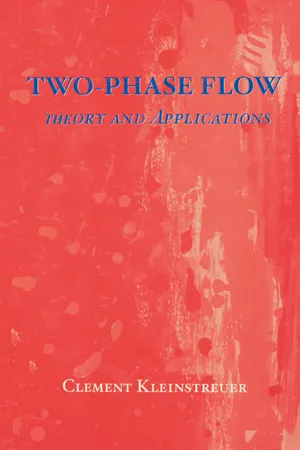
- 512 pages
- English
- ePUB (mobile friendly)
- Available on iOS & Android
eBook - ePub
About this book
This graduate text provides a unified treatment of the fundamental principles of two-phase flow and shows how to apply the principles to a variety of homogeneous mixture as well as separated liquid-liquid, gas-solid, liquid-solid, and gas-liquid flow problems, which may be steady or transient, laminar or turbulent.Each chapter contains several sample problems, which illustrate the outlined theory and provide approaches to find simplified analytic descriptions of complex two-phase flow phenomena.This well-balanced introductory text will be suitable for advanced seniors and graduate students in mechanical, chemical, biomedical, nuclear, environmental and aerospace engineering, as well as in applied mathematics and the physical sciences. It will be a valuable reference for practicing engineers and scientists. A solutions manual is available to qualified instructors.
Frequently asked questions
Yes, you can cancel anytime from the Subscription tab in your account settings on the Perlego website. Your subscription will stay active until the end of your current billing period. Learn how to cancel your subscription.
No, books cannot be downloaded as external files, such as PDFs, for use outside of Perlego. However, you can download books within the Perlego app for offline reading on mobile or tablet. Learn more here.
Perlego offers two plans: Essential and Complete
- Essential is ideal for learners and professionals who enjoy exploring a wide range of subjects. Access the Essential Library with 800,000+ trusted titles and best-sellers across business, personal growth, and the humanities. Includes unlimited reading time and Standard Read Aloud voice.
- Complete: Perfect for advanced learners and researchers needing full, unrestricted access. Unlock 1.4M+ books across hundreds of subjects, including academic and specialized titles. The Complete Plan also includes advanced features like Premium Read Aloud and Research Assistant.
We are an online textbook subscription service, where you can get access to an entire online library for less than the price of a single book per month. With over 1 million books across 1000+ topics, we’ve got you covered! Learn more here.
Look out for the read-aloud symbol on your next book to see if you can listen to it. The read-aloud tool reads text aloud for you, highlighting the text as it is being read. You can pause it, speed it up and slow it down. Learn more here.
Yes! You can use the Perlego app on both iOS or Android devices to read anytime, anywhere — even offline. Perfect for commutes or when you’re on the go.
Please note we cannot support devices running on iOS 13 and Android 7 or earlier. Learn more about using the app.
Please note we cannot support devices running on iOS 13 and Android 7 or earlier. Learn more about using the app.
Yes, you can access Two-Phase Flow by Cl Kleinstreuer in PDF and/or ePUB format, as well as other popular books in Physical Sciences & Thermodynamics. We have over one million books available in our catalogue for you to explore.
Information
Topic
Physical SciencesSubtopic
ThermodynamicsChapter 1
REVIEW OF SINGLE-PHASE FLOW
A sound understanding of the physics of single-phase flow and a mastery of solution techniques for single-phase flow problems are important prerequisites for studying two-phase or multiphase flow systems. Two-phase flow is best described as the flow of two different kinds of matter, e.g., solid particles in a gas or liquid, gas bubbles in a liquid, or droplets in a gas stream. As always, the objective is to learn to develop mathematical models, here, approximate representations of actual two-phase flow phenomena in terms of differential or integral equations. The (numerical) solutions to the describing equations should produce testable predictions and allow for the analysis of two-phase system variations leading to a deeper understanding and possibly to new or improved system designs.
Traditionally, the answer to a given (flow) problem is obtained by copying suitable equations, submodels, and boundary conditions with their appropriate solution techniques from available sources. This is called “matching” and may result in a good first-step learning experience; however, it should be augmented later on by more independent work, e.g., deriving governing equations, plotting and visualizing results, improving basic submodels, finding new, interdisciplinary applications, exploring new concepts, interpreting observations in a more generalized form, or even pushing the envelope of existing solution techniques. In any case, the triple pedagogical goals of understanding, skills, and design can be achieved only via independent practice, hard work, and creative thinking. ...
Table of contents
- Cover
- Title Page
- Copyright Page
- Table of Contents
- Preface
- 1 REVIEW OF SINGLE-PHASE FLOW
- 2 BASIC CONCEPTS OF TWO-PHASE FLOW THEORY
- 3 DERIVATIONS OF TWO-PHASE FLOW MODELING EQUATIONS
- 4 ANALYSES AND NUMERICAL SIMULATIONS OF BASIC TWO-PHASE FLOWS
- 5 SELECTED CASE STUDIES
- APPENDICES
- INDEX